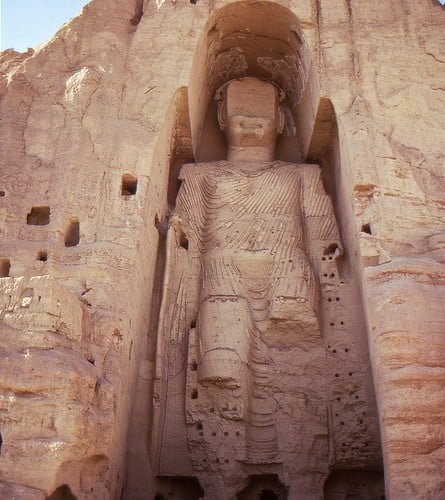Art World
Will Afghanistan Rebuild the Buddhas of Bamiyan?
Should the niches remain empty as a memorial, or the Buddhas be remade?
Should the niches remain empty as a memorial, or the Buddhas be remade?
Sarah Cascone

There is a movement to rebuild the Buddhas of Bamiyan, destroyed by the Taliban in 2001, in order to promote tourism in Afghanistan, reports Roads and Kingdoms.
One local man, Mohammad Reza Ibrahim, is leading the efforts to entice foreigners back, and show them that his country has much to offer in areas removed from conflict. “Bamiyan has a great potential for tourism,” he told told Roads and Kingdoms. “Bamiyan is different from other provinces in Afghanistan. When you come to Bamiyan, you feel safe and secure.” He is currently teaching the first class of tourism majors at the local university. His 30 students will serve as tour guides upon their graduation in the spring.
Even without the 174- and 115-foot-tall Buddhas that once stood vigil in its cliffs, Bamiyan boasts several major attractions: ruined ancient cities, caves decorated in oil paintings—thought to be the oldest in the world—and the country’s first national park, as well as its only ski slope.
The 6th century statues survived a siege by none other than Genghis Khan in 1221. In 2001, however, Taliban leader Mullah Omar called for their destruction after deeming the Buddhas idolatrous. The sculptures were blown to pieces, leaving behind two empty niches, which stand as a constant reminder of what has been lost.

The Bamiyan Buddha in 1973.
Photo: Via Flickriver.
Without them, Bamiyan’s tourism remains at a nadir, with only 4,300 foreign visitors to the region over the last five years, as compared to 4,000 in 2005 alone. The Afghan government hopes to rebuild the Buddhas as a sign of victory over the Taliban. UNESCO, which continues to place the site on its World Heritage List, is fundamentally opposed to reproduction of the statues—not enough of the original material remains for a reconstruction. In 2012, a consultant expressed his belief that “the void is the true sculpture.”
Last year, German conservationists from the International Council on Monuments and Sites (ICOMOS) did preliminary work on the smallest niche, building two brick pillars that looked like legs, ostensibly as a stabilizing platform. UNESCO’s response was swift and unflinching: ICOMOS’s actions, “bordering on criminal,” had caused “irreversible damage.”
In an interview with the New York Times, the president of ICOMOS’s German branch, Michael Petzet, reaffirmed that the bricks were put there for safety reasons. But he also suggested that “maybe in the future if the Afghan government wants to make a little bit more, they can build upon this.” Before they do so, however, Afghan officials have to decide what is more fitting: leaving the empty niches as a memorial to loss, or rebuilding the Buddhas as Bamiyan looks to the future.